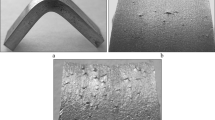Conclusions
-
1.
The tendency of steel toward hydrogen embrittlement depends upon the content of free hydrogen. Hydrogen embrittlement may not occur even with a high total hydrogen content in the steel if the primary portion of it is in the combined state.
-
2.
Free hydrogen is present in steel in the form of protons. Under the action of an electric current the process of electron transfer of the hydrogen develops.
-
3.
The combined hydrogen is found in the molecular state (in collectors) and in chemical compounds.
Electric current treatment of hydrogen-impregnated steel promotes a decrease in the quantity of free hydrogen and an increase in the content of combined.
With the addition to the steel of the chrome-cerium alloy the quantity of free hydrogen decreases and that of combined increases in connection with the formation of cerium compounds with hydrogen in the carbides. li]4.Electric-current treatment and the addition of cerium provide an increase in the characteristics of plasticity of hydrogen impregnated steel as the result of a decrease in the quantity of free hydrogen. Modification with cerium sharply reduces the flake sensitivity of steel in connection with the reduction in hydrogen embrittlement.
Similar content being viewed by others
Literature cited
A. Kh. Cottrell, Dislocations and Plastic Flow in Metals [in Russian], Metallurgizdat, Moscow (1958).
M. Cornet and T. Besnards, Met. Sci., No. 7 335 (1978).
A. A. Astaf'ev, “Rational cycles for annealing large forgings after forging,” Metalloved. Term. Obrab. Met., No. 5, 2 (1962).
V. V. Panasyuk, S. E. Kovchik, and G. I. Smoroda, “Methods of evaluating the hydrogen brittleness of constructional materials,” Fiz.-Khim. Mekh. Mater., No. 3, 5 (1979).
E. A. Steigerwald, F. W. Shaller, and A. R. Troiano, Trans. Met. Soc. ASME,215, No. 6, 16 (1959).
A. A. Astaf'ev, “Preliminary heat treatment of forgings,” Metalloved. Term. Obrab. Met., No. 9, 2 (1978).
V. I. Sarrak, “Hydrogen embrittlement and the structural condition of steel,” Metalloved. Term. Obrab. Met., No. 5, 11 (1982).
Additional information
Scientific and Production Union of the Central Scientific-Research Institute for Machine Building Technology. Translated from Metallovedenie i Termicheskaya Obrabotka Metallov, No. 2, pp. 2–7, February, 1984.
Rights and permissions
About this article
Cite this article
Astaf'ev, A.A. Hydrogen embrittlement of constructional steels. Met Sci Heat Treat 26, 91–96 (1984). https://doi.org/10.1007/BF00707152
Issue Date:
DOI: https://doi.org/10.1007/BF00707152



